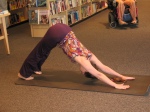 Writers wrestle in solitary confinement to create work worthy of distribution to the masses. We listen to our guts writhe and dare to write down the utterances. We literally tap into the deepest seams of human components and release the secrets of the spirit in print for everyone to see. Such creatures would be “pedastalized” in a truly free and creative world. But we aren’t.
Writers wrestle in solitary confinement to create work worthy of distribution to the masses. We listen to our guts writhe and dare to write down the utterances. We literally tap into the deepest seams of human components and release the secrets of the spirit in print for everyone to see. Such creatures would be “pedastalized” in a truly free and creative world. But we aren’t.
Writers are eccentric. Writers are different. You never know where a writer’s mind is even if you are standing in front of her looking into her eyes. Significant others just get used to it. Even though the whole world relies on some aspect of a writer’s abilities, the writer is sectioned off “to work”, but really to put us where they can keep an eye on us! Lest we indulge in daydreaming, talking to ourselves, or something worse like the historical bad writer habits of alcohol or drugs.
Almost everyone knows of Hemingway’s alcohol problems or Poe’s drug abuse. Why does the world have this negative image of writers? Because history has a passion for emphasizing the foibles of the greats in an attempt to claim, “He was a great writer in spite of his flaws.”
Flaws. Imperfections. Blemishes. This is the stuff that makes us individuals, that makes us lovable, that gives writers a different perspective on the world. A writer’s vantage point is precisely where her voice emanates. What makes a writer is someone who notices that their voice and their turn of mind come from the same immeasurable place. When I wrote my first short story in grade school from the outlook of two shoes talking to each other in a dark shoe box, I heard my voice for the first time. Writers can see, feel, think, smell, and hear the worlds of other people and objects. It’s what we do.
“I’m a writer. I use everything,” said Truman Capote. To truly be a writer, regardless of genre, you must ‘muse’ everything in your world and in your mind to the advantage of your craft. It’s a task that comes easier for some writers than others. It’s a question of listening and being open to what you hear. How can you evolve into the grand writer you desire to be? By leading a daily life devoted to expanding your body, mind, and spirit in every sense of the word. By following the way of Writer Wellness.
The idea of Writer Wellness happened to me because of a hectic schedule and the natural instinct to “use everything” around me to create my writing. When I was expecting my first baby, I published a magazine article about continuing to run a dance studio while pregnant. When a guest artist taught classes at our local community theatre, I published an article about his career on Broadway. When my life got wonderfully full of children, a household, work, and writing deadlines, I organized a system that would allow me to listen to my inner and outer worlds and maintain my writing voice.
Writer Wellness is composed of regular practices of journal writing, exercise, relaxation, nutrition, and creative play. For example, depending on my schedule, my daily journal entry may be three pages long or just the front of an index card. Exercise is either walking the dog, yoga practice, cardio equipment, or walking. I ALWAYS find at least five minutes a day to close my eyes and meditate. The food I eat is simple and grown as locally as possible.
Writer Wellness evolved from a personal habit to a community program and then into a book. I follow the principles and guide others to do the same. It’s a simple, developmental approach that any writer can try in any degree. The results are tumultuous productivity and long term good health. And triumph over flaws by using what you know as a writer to make your life and writing better.
How did you triumph over some imperfections to become who you are today?
There are five primary areas of practice to the Writer Wellness plan. Every other week I will post an idea for relaxation (Monday Meditation,) creative play (Tuesday Tickle,) fitness and exercise (Wednesday Workout,) journaling and misc. (Thursday Thought,) and nutrition (Friday Feast.)
 Meanwhile, remember to look for a digital or print copy of Writer Wellness, A Writer’s Path to Health and Creativity at Who Dares Wins Publishing, http://whodareswinspublishing.com.
Meanwhile, remember to look for a digital or print copy of Writer Wellness, A Writer’s Path to Health and Creativity at Who Dares Wins Publishing, http://whodareswinspublishing.com.
Be well, write well.










